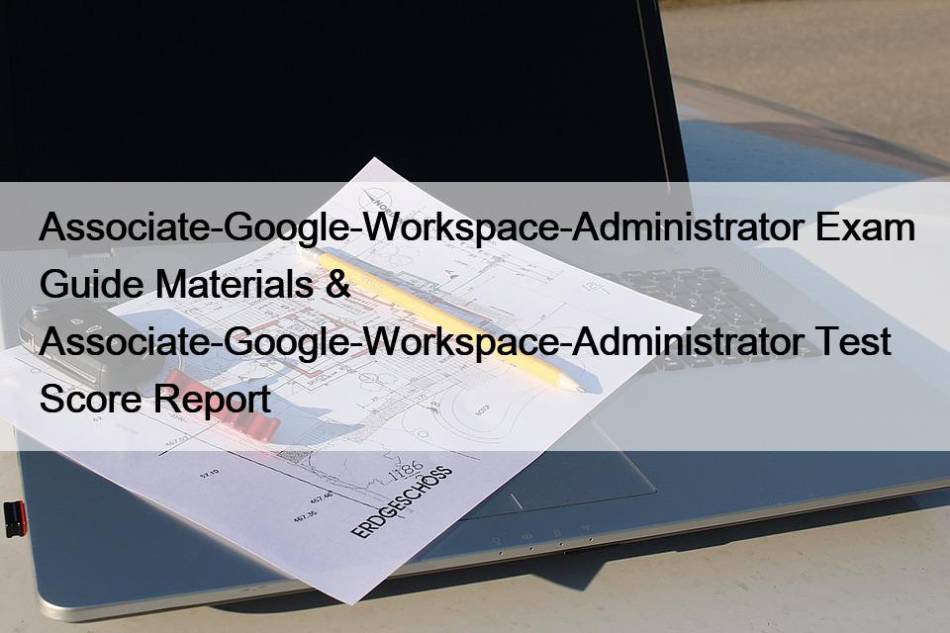Most Popular
 Latest Ethics-In-Technology Test Questions - Ethics-In-Technology Study Material
Latest Ethics-In-Technology Test Questions - Ethics-In-Technology Study Material
As a member of the people working in the Ethics-In-Technology ...
 Pass Guaranteed 2025 Professional Ethics-In-Technology: WGU Ethics In Technology QCO1 Latest Exam Experience
Pass Guaranteed 2025 Professional Ethics-In-Technology: WGU Ethics In Technology QCO1 Latest Exam Experience
P.S. Free 2025 WGU Ethics-In-Technology dumps are available on Google ...
 Pass Guaranteed Accurate Apple - DEP-2025 - Apple Deployment and Management Exam Reliable Test Forum
Pass Guaranteed Accurate Apple - DEP-2025 - Apple Deployment and Management Exam Reliable Test Forum
DEP-2025 latest torrents simulate the real exam environment and does ...



Associate-Google-Workspace-Administrator Exam Guide Materials & Associate-Google-Workspace-Administrator Test Score Report

Once you decide to pass the Associate Google Workspace Administrator exam and get the certification, you may encounter many handicaps that you don’t know how to deal with, so, you may think that it is difficult to pass the exam and get the certification. In order to help you solve these problem and help you pass the exam easy, we complied such a Associate-Google-Workspace-Administrator exam torrent. We can promise that you will have no regret buying our Associate Google Workspace Administrator exam dumps. If you are hesitating to buy our Associate-Google-Workspace-Administrator Test Quiz, if you are anxious about whether our product is suitable for you or not, we think you can download the trail version. We believe our Associate Google Workspace Administrator exam dumps will help you make progress and improve yourself.
Google Associate-Google-Workspace-Administrator Exam Syllabus Topics:
| Topic | Details |
|---|---|
| Topic 1 |
|
| Topic 2 |
|
| Topic 3 |
|
| Topic 4 |
|
>> Associate-Google-Workspace-Administrator Exam Guide Materials <<
Free PDF Quiz Marvelous Google Associate-Google-Workspace-Administrator Exam Guide Materials
In order to gain the certification quickly, people have bought a lot of study materials, but they also find that these materials don’t suitable for them and also cannot help them. If you also don’t find the suitable Associate-Google-Workspace-Administrator test guide, we are willing to recommend that you should use our study materials. Because our products will help you solve the problem, it will never let you down if you decide to purchase and practice our Associate-Google-Workspace-Administrator latest question.
Google Associate Google Workspace Administrator Sample Questions (Q80-Q85):
NEW QUESTION # 80
You are migrating your organization's email to Google Workspace. Your organization uses the terramearth.com email domain. You need to configure Google Workspace to receive emails sent to terramearth.com. What should you do?
- A. Create a domain alias for terramearth.com in Google Workspace. Configure email forwarding to redirect emails to the new Google Workspace accounts.
- B. Establish a Transport Layer Security (TLS) connection between your company's existing mail servers and Google's mail servers
- C. Configure an email address in Google Workspace to capture emails sent to unverified domains, including terramearth.com.
- D. Add terramearth.com as a primary, secondary, or alias domain in Google Workspace. Update the Mail Exchange (MX) records with your domain registrar to direct mail flow to Google's mail servers.
Answer: D
Explanation:
To receive emails for your domain (terramearth.com) in Google Workspace, you need to add the domain to Google Workspace as either a primary, secondary, or alias domain, depending on your organization's requirements. After adding the domain, you must update the Mail Exchange (MX) records at your domain registrar to point to Google's mail servers. This step is essential to ensure that emails are correctly routed to Google Workspace.
NEW QUESTION # 81
Your company wants to minimize distractions and inappropriate content in their Google Chat spaces. You need to give trusted employees the ability to remove messages and ban users from specific Chat spaces. What should you do?
- A. Create a data loss prevention (DLP) rule that blocks inappropriate content from being shared
- B. Assign the trusted employees as moderators for the relevant Chat spaces.
- C. Disable all Chat spaces except those specifically approved by management.
- D. Use the security investigation tool to audit and monitor Chat messages.
Answer: B
Explanation:
Assigning trusted employees as moderators for the relevant Chat spaces will give them the necessary privileges to remove messages and ban users when needed. This is the most efficient way to control inappropriate content and maintain a positive and productive environment within the spaces. Moderators can take action to address issues directly without requiring more complex or restrictive solutions.
NEW QUESTION # 82
You are applying device and user policies for employees in your organization who are in different departments. You need each department to have a different set of policies. You want to follow Google-recommended practices. What should you do?
- A. Create an Access group for each department. Configure the applicable policies.
- B. Create separate top-level organizational units for each department.
- C. Create a child organizational unit for each department.
- D. Add all managed users and devices in the top-level organizational unit.
Answer: C
Explanation:
Google recommends using the organizational unit (OU) structure for applying different settings and policies to different groups of users and devices within your Google Workspace domain. To apply a unique set of policies to each department, you should create a child organizational unit for each department under your main domain structure.
Here's why option D aligns with Google's best practices and why the others are less suitable:
D . Create a child organizational unit for each department.
Organizational units provide a hierarchical structure for managing users and devices. By creating a child OU for each department, you can then apply specific device and user policies to that OU. Users and devices within a child OU inherit policies from parent OUs but can also have OU-specific policies that override or supplement the inherited ones. This allows for granular control and ensures that each department can have the policies tailored to its needs. This is the recommended method by Google for managing policies based on departments or other logical groupings within an organization.
Associate Google Workspace Administrator topics guides or documents reference: The official Google Workspace Admin Help documentation on "How the organizational structure works" and "Apply settings for specific groups of users or devices" (or similar titles) clearly explains the purpose and benefits of using OUs for policy management. It emphasizes the hierarchical nature and how policies are applied and inherited through the OU structure. Creating child OUs for departments is a direct application of this recommended practice.
A . Create separate top-level organizational units for each department.
Creating separate top-level OUs for each department is generally not recommended for managing policies within the same organization. Top-level OUs are meant to represent distinct functional or administrative units that might have their own domain settings and administrators. Managing all departments under a single domain but in separate top-level OUs can complicate overall administration, sharing, and user management across the organization. Child OUs within a single domain provide the necessary separation for policy application while maintaining a unified organizational structure.
Associate Google Workspace Administrator topics guides or documents reference: Google's documentation on organizational structure usually advises on creating a logical hierarchy of child OUs under a single top-level OU representing the organization. Separating departments into top-level OUs is not a standard or recommended practice for policy management within a single domain.
B . Create an Access group for each department. Configure the applicable policies.
Access groups are primarily used for controlling access to specific resources or services. While you can manage group membership based on departments, policies for users and devices are typically applied at the organizational unit level, not directly to access groups. While some settings might be influenced by group membership, OUs are the primary mechanism for policy enforcement.
Associate Google Workspace Administrator topics guides or documents reference: The Google Workspace Admin Help distinguishes between organizational units and groups (including access groups). Policies are consistently described as being applied to OUs. Groups are for managing access and collaboration.
C . Add all managed users and devices in the top-level organizational unit.
Applying all policies at the top-level OU would mean that all users and devices inherit the same set of policies. This contradicts the requirement of having different policies for each department. To achieve department-specific policies, you need to organize users and devices into separate OUs.
Associate Google Workspace Administrator topics guides or documents reference: Google's documentation emphasizes the flexibility of the OU structure to apply different policies to different subsets of users and devices. Placing everyone in the top-level OU negates this flexibility.
Therefore, the Google-recommended practice for applying different device and user policies to employees in different departments is to create a child organizational unit for each department. This allows for targeted policy application and management within the overall organizational structure.
NEW QUESTION # 83
An employee with a Workspace Business Plus license at your company is going on a long leave soon. The employee will not need access to their Google Workspace data, but their teammates will need access to the employee's dat a. When the employee returns from leave, you will need to restore access to their account, data, emails, and shared documents. You need to preserve the employee's Workspace data while also minimizing cost while they are on leave. What should you do?
- A. Export the account data by using Takeout, and remove the user license in the Admin console.
- B. Purchase an Archived User license and assign the license to the employee.
- C. Suspend their account in the Admin console.
- D. Copy the employee's emails, and transfer their file ownership to a teammate. Delete the user account.
Answer: B
Explanation:
To preserve an employee's Google Workspace data while they are on long leave, allow teammates access to that data, and minimize costs with the intention of fully restoring the account upon their return, the best course of action is to purchase an Archived User license and assign it to the employee.
Here's why option B is the most suitable and cost-effective solution that meets all the requirements:
B . Purchase an Archived User license and assign the license to the employee.
Google Workspace offers Archived User licenses at a significantly lower cost than a full user license. When you assign an Archived User license to an account, the data (including Gmail, Drive, and other Workspace services) is retained and can be accessed by other authorized users (e.g., administrators or delegated teammates). The user themselves cannot log in or use the services, thus minimizing cost. Upon the employee's return, you can easily reassign a full Business Plus license to their account, restoring their full access without any data loss or complex restoration processes.
Associate Google Workspace Administrator topics guides or documents reference: The official Google Workspace Admin Help documentation on "About Archived User licenses" (or similar titles) explicitly describes this scenario as the intended use case for Archived User licenses. It outlines the reduced cost, the preservation of data, the ability for administrators to access the data (and delegate access), and the seamless transition back to a full license when the user returns.
A . Suspend their account in the Admin console.
Suspending an account prevents the user from accessing it, but it typically retains the full license cost. While an administrator might be able to access some data in a suspended account, it doesn't offer the cost savings of an Archived User license. Additionally, depending on the suspension duration and Google's policies, there might be implications for long-term data retention without an active or archived license.
Associate Google Workspace Administrator topics guides or documents reference: The Google Workspace Admin Help documentation on "Suspend or restore users" explains the functionality of account suspension. It primarily focuses on temporarily revoking access, not on long-term, cost-effective data preservation with potential for delegated access.
C . Export the account data by using Takeout, and remove the user license in the Admin console.
While Google Takeout allows you to export user data, this creates a separate archive that is not directly integrated with Google Workspace. Providing teammates access to this exported data would be cumbersome and not as seamless as accessing it within the original Workspace environment. Removing the user license would stop data retention in Google Workspace, and restoring the account fully upon the employee's return would involve re-importing the data, which can be complex, time-consuming, and potentially lead to data loss or inconsistencies. This option does minimize cost by removing the license but at the expense of easy access and seamless restoration.
Associate Google Workspace Administrator topics guides or documents reference: Documentation on Google Takeout describes its purpose for exporting data out of Google services, primarily for personal use or data migration, not for temporary data preservation and collaborative access within the Workspace environment. Removing a license typically leads to data deletion after a certain period unless an alternative (like an Archived User license) is in place.
D . Copy the employee's emails, and transfer their file ownership to a teammate. Delete the user account.
This approach involves significant data manipulation and potential loss of context. Copying emails might not preserve the entire mailbox structure and could miss important information. Transferring file ownership can be complex and might not cover all types of data or shared items. Deleting the user account would permanently remove the data, making full restoration upon the employee's return impossible. This option is not suitable for preserving the employee's Workspace data and restoring their account later.
Associate Google Workspace Administrator topics guides or documents reference: Google Workspace's account management best practices emphasize preserving user accounts and data for returning employees. Deleting accounts with the intention of temporary leave is strongly discouraged due to the difficulty and risks associated with data recovery and account recreation.
Therefore, the most appropriate action that meets all the requirements of preserving data, providing access to teammates, minimizing cost during the leave, and allowing for full restoration upon return is to purchase an Archived User license and assign it to the employee.
NEW QUESTION # 84
Per regulatory requirements, your company is required to keep the data of employees located in Germany within Europe and the data of employees located in the US within the US. The employees in Germany are in a separate organizational unit (OU) than employees in the US. You need to ensure that where employee data is stored is in compliance with the location regulations.
What should you do?
- A. Navigate to the Data Regions function in the Admin console. Select the Europe region for employees in Germany, and select the US region for US employees.
- B. Instruct employees to use Drive for desktop to keep documents on their corporate computers.
- C. Create two Groups. Assign employees into the Germany or US Group based on their location. Use Google Drive trust rules to prevent sharing between the Groups.
- D. Navigate to the Data Regions function in the Admin console. Select 'No preference.'
Answer: A
Explanation:
Using the Data Regions function in the Google Admin console, you can specify where data is stored for different organizational units (OUs) based on their geographical location. This ensures that employee data for those in Germany is stored within Europe, while data for US employees is stored within the US, meeting the regulatory requirements for data locality. This approach automates compliance and eliminates the need for manual tracking or additional configurations.
Okay, I will carefully review the question and provide a 100% verified answer based on the official Associate Google Workspace Administrator documentation, correct any typing errors, and present it in the requested format.
NEW QUESTION # 85
......
The world is changing, so we should keep up with the changing world's step as much as possible. Our ExamTorrent has been focusing on the changes of Associate-Google-Workspace-Administrator exam and studying in the exam, and now what we offer you is the most precious Associate-Google-Workspace-Administrator test materials. After you purchase our dump, we will inform you the Associate-Google-Workspace-Administrator update messages at the first time; this service is free, because when you purchase our study materials, you have bought all your Associate-Google-Workspace-Administrator exam related assistance.
Associate-Google-Workspace-Administrator Test Score Report: https://www.examtorrent.com/Associate-Google-Workspace-Administrator-valid-vce-dumps.html
- Dumps Associate-Google-Workspace-Administrator Vce 🟢 Authorized Associate-Google-Workspace-Administrator Pdf 😬 Latest Associate-Google-Workspace-Administrator Examprep 📪 Open ➤ www.free4dump.com ⮘ and search for ➽ Associate-Google-Workspace-Administrator 🢪 to download exam materials for free 🍄Associate-Google-Workspace-Administrator Test Answers
- Associate-Google-Workspace-Administrator Test Answers 🏵 Latest Associate-Google-Workspace-Administrator Exam Discount 😈 Exam Associate-Google-Workspace-Administrator Success 🛢 Enter ☀ www.pdfvce.com ️☀️ and search for ▶ Associate-Google-Workspace-Administrator ◀ to download for free ➰Associate-Google-Workspace-Administrator Exam Dump
- Pass-Sure Associate-Google-Workspace-Administrator Exam Guide Materials | Amazing Pass Rate For Associate-Google-Workspace-Administrator: Associate Google Workspace Administrator | Useful Associate-Google-Workspace-Administrator Test Score Report ✋ Open website 【 www.testkingpdf.com 】 and search for ⮆ Associate-Google-Workspace-Administrator ⮄ for free download 🏂Associate-Google-Workspace-Administrator New Exam Camp
- Free PDF Quiz Google - Associate-Google-Workspace-Administrator –Efficient Exam Guide Materials 🛫 Search for ✔ Associate-Google-Workspace-Administrator ️✔️ and download it for free on { www.pdfvce.com } website 🧱New Associate-Google-Workspace-Administrator Test Sample
- Google Associate-Google-Workspace-Administrator Exam Dumps - Get Success www.prep4away.com Minimal Effort 🔅 Copy URL ☀ www.prep4away.com ️☀️ open and search for ➽ Associate-Google-Workspace-Administrator 🢪 to download for free 🐚Associate-Google-Workspace-Administrator Latest Test Format
- 2025 Perfect 100% Free Associate-Google-Workspace-Administrator – 100% Free Exam Guide Materials | Associate Google Workspace Administrator Test Score Report ☀ Open ( www.pdfvce.com ) enter 【 Associate-Google-Workspace-Administrator 】 and obtain a free download 🕵Real Associate-Google-Workspace-Administrator Torrent
- 2025 Perfect 100% Free Associate-Google-Workspace-Administrator – 100% Free Exam Guide Materials | Associate Google Workspace Administrator Test Score Report ✡ Search for ➠ Associate-Google-Workspace-Administrator 🠰 and obtain a free download on { www.pass4test.com } 🤯Associate-Google-Workspace-Administrator Vce Files
- Associate-Google-Workspace-Administrator Exam Dump 💂 Associate-Google-Workspace-Administrator New Exam Materials 🚀 Authorized Associate-Google-Workspace-Administrator Pdf 🐐 Go to website 「 www.pdfvce.com 」 open and search for ▶ Associate-Google-Workspace-Administrator ◀ to download for free 🙍Training Associate-Google-Workspace-Administrator For Exam
- Associate-Google-Workspace-Administrator New Exam Camp 🏪 Associate-Google-Workspace-Administrator Premium Exam 🔥 Latest Associate-Google-Workspace-Administrator Exam Discount 🚧 Open website 【 www.passtestking.com 】 and search for “ Associate-Google-Workspace-Administrator ” for free download 👬New Associate-Google-Workspace-Administrator Study Materials
- Free PDF Quiz Google - Associate-Google-Workspace-Administrator –Efficient Exam Guide Materials 🚻 Go to website 《 www.pdfvce.com 》 open and search for 「 Associate-Google-Workspace-Administrator 」 to download for free ⭐Associate-Google-Workspace-Administrator Exam Dump
- Is It Important To Get Google Associate-Google-Workspace-Administrator Exam Material For The Exam? 🛬 Search for { Associate-Google-Workspace-Administrator } and obtain a free download on ⮆ www.actual4labs.com ⮄ 🙄Exam Associate-Google-Workspace-Administrator Success
- Associate-Google-Workspace-Administrator Exam Questions
- e-learning.kelasekstra.net upskilllab.simpleforedesign.com netriacademy.in tutor1.gerta.pl mapadvantagesat.com heduventure.com learn.createspaceafrica.com imcourses.org online-courses.org.uk harryco265.ambien-blog.com
Tags: Associate-Google-Workspace-Administrator Exam Guide Materials, Associate-Google-Workspace-Administrator Test Score Report, Latest Associate-Google-Workspace-Administrator Study Materials, Valid Dumps Associate-Google-Workspace-Administrator Free, Associate-Google-Workspace-Administrator Valid Test Voucher